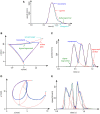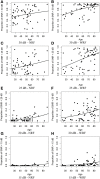The lognormal handwriter: learning, performing, and declining
- PMID: 24391610
- PMCID: PMC3867641
- DOI: 10.3389/fpsyg.2013.00945
The lognormal handwriter: learning, performing, and declining
Abstract
The generation of handwriting is a complex neuromotor skill requiring the interaction of many cognitive processes. It aims at producing a message to be imprinted as an ink trace left on a writing medium. The generated trajectory of the pen tip is made up of strokes superimposed over time. The Kinematic Theory of rapid human movements and its family of lognormal models provide analytical representations of these strokes, often considered as the basic unit of handwriting. This paradigm has not only been experimentally confirmed in numerous predictive and physiologically significant tests but it has also been shown to be the ideal mathematical description for the impulse response of a neuromuscular system. This latter demonstration suggests that the lognormality of the velocity patterns can be interpreted as reflecting the behavior of subjects who are in perfect control of their movements. To illustrate this interpretation, we present a short overview of the main concepts behind the Kinematic Theory and briefly describe how its models can be exploited, using various software tools, to investigate these ideal lognormal behaviors. We emphasize that the parameters extracted during various tasks can be used to analyze some underlying processes associated with their realization. To investigate the operational convergence hypothesis, we report on two original studies. First, we focus on the early steps of the motor learning process as seen as a converging behavior toward the production of more precise lognormal patterns as young children practicing handwriting start to become more fluent writers. Second, we illustrate how aging affects handwriting by pointing out the increasing departure from the ideal lognormal behavior as the control of the fine motricity begins to decline. Overall, the paper highlights this developmental process of merging toward a lognormal behavior with learning, mastering this behavior to succeed in performing a given task, and then gradually deviating from it with aging.
Keywords: aging; handwriting analysis and generation; kinematic theory; learning; lognormal models; lognormality; neuromuscular systems.
Figures






Similar articles
-
Central and Peripheral Shoulder Fatigue Pre-screening Using the Sigma-Lognormal Model: A Proof of Concept.Front Hum Neurosci. 2020 May 19;14:171. doi: 10.3389/fnhum.2020.00171. eCollection 2020. Front Hum Neurosci. 2020. PMID: 32508608 Free PMC article.
-
Kinematic analysis of fast pen strokes in children with ADHD.Appl Neuropsychol Child. 2020 Apr-Jun;9(2):125-140. doi: 10.1080/21622965.2018.1550402. Epub 2019 Feb 6. Appl Neuropsychol Child. 2020. PMID: 30724588
-
Studying the variability of handwriting patterns using the Kinematic Theory.Hum Mov Sci. 2009 Oct;28(5):588-601. doi: 10.1016/j.humov.2009.01.005. Epub 2009 Mar 27. Hum Mov Sci. 2009. PMID: 19328575
-
The importance of handwriting speed in adult writing.Dev Neuropsychol. 2006;29(1):197-216. doi: 10.1207/s15326942dn2901_10. Dev Neuropsychol. 2006. PMID: 16390294 Review.
-
Motor control of handwriting in the developing brain: A review.Cogn Neuropsychol. 2017 May-Jun;34(3-4):187-204. doi: 10.1080/02643294.2017.1367654. Epub 2017 Sep 11. Cogn Neuropsychol. 2017. PMID: 28891745 Review.
Cited by
-
Linking brain stroke risk factors to human movement features for the development of preventive tools.Front Aging Neurosci. 2014 Jul 8;6:150. doi: 10.3389/fnagi.2014.00150. eCollection 2014. Front Aging Neurosci. 2014. PMID: 25071559 Free PMC article.
-
New online in-air signature recognition dataset and embodied cognition inspired feature selection.Sci Rep. 2025 Jun 2;15(1):19314. doi: 10.1038/s41598-025-03917-5. Sci Rep. 2025. PMID: 40456805 Free PMC article.
-
A 12-Week Cycling Training Regimen Improves Upper Limb Functions in People With Parkinson's Disease.Front Hum Neurosci. 2018 Sep 11;12:351. doi: 10.3389/fnhum.2018.00351. eCollection 2018. Front Hum Neurosci. 2018. PMID: 30254577 Free PMC article.
-
A deep learning model of dorsal and ventral visual streams for DVSD.Sci Rep. 2024 Nov 10;14(1):27464. doi: 10.1038/s41598-024-78304-7. Sci Rep. 2024. PMID: 39523365 Free PMC article.
-
Handwriting Declines With Human Aging: A Machine Learning Study.Front Aging Neurosci. 2022 May 6;14:889930. doi: 10.3389/fnagi.2022.889930. eCollection 2022. Front Aging Neurosci. 2022. PMID: 35601625 Free PMC article.
References
-
- Albaret J.-M., Santamaria M. (1996). Utilisation des digitaliseurs dans l'étude des caractéristiques motrices de l'écriture. Evolutions Psychomotrices 8, 115–119
-
- Alimi A., Plamondon R. (1994). Analysis of the parameter dependence of handwriting generation models on movements characteristic», in Advances in Handwriting and Drawing: A Multidisciplinary Approach, eds Faure C., Lorette G., Vinter A., Keuss P. (Paris: Europia; ), 363–378
-
- Alimi M. A. (2003). Beta neuro-fuzzy systems, in TASK Quaterly J. Special, Vol. 7, eds Duch W., Rutkowska D. (Gdansk: Scientific Bulletin of the Academic Computer Centre; ), 23–41
-
- Almaksour A., Anquetil E., Plamondon R., O'Reilly C. (2011). Synthetic handwritten gesture generation using sigma-logormal model for evolving handwriting classifier, in Proceedings of the 15th Biennal Conference of the International Graphonomics Society (Cancún: IGS; ), 98–101
-
- Awaida S. M., Mahmoud S. A. (2012). State of the art in off-line writer identification of handwritten text and survey of writer identification of Arabic text. Educ. Res. Rev. 7, 445–463 10.5897/ERR11.303 - DOI
LinkOut - more resources
Full Text Sources
Other Literature Sources

